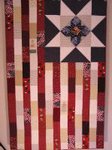Updated 3/2017-- photos and all links (except to my own posts) removed
as many are no longer active and it was easier than checking each one.
Wounds in palliative care patients may be related to their underlying malignancy or to skin breakdown (poor nutrition, advanced age, poor perfusion, etc). Wounds and associated skin changes that develop in palliative patients are generally considered as nonhealable.
Therefore, the goal is refocused in an attempt to reduce emotional distress to patients and their families as well as reduction of local physical wound issues. The article defines these issues using the mnemonic HOPES: Hemorrhage, Odor, Pain, Exudate, and Superficial infection.
The article reminds us that malignant wounds (due to cutaneous mets) have been estimated to affect 5% to 19% of patients with metastatic disease. The chest, breasts, and the head and neck, followed by the abdomen, are the most common sites for these metastatic malignant wounds.
Regardless of the cause, if the wound has been determined to be a non-healable wound, then the goals remain as above—reduce the patients emotional distress and address the “HOPES.”
H: Hemorrhage (or bleeding)May be due to granulation tissue or to tumor erosion into a blood vessel.
For minor bleeding, agents such as calcium alginates are readily available as a wound dressing. Calcium, as part of the alginate, is released into the wound in exchange for sodium, potentially triggering the coagulation cascade. The sodium alginate then converts the fiber to a hydrogel, promoting local comfort and protection. In severe cases, suturing a proximal vessel, intravascular embolization, laser treatment, cryotherapy, radiotherapy, and electrical cauterization may be necessary.
O: Odor
Unpleasant odor and putrid discharge are associated with increased bacterial burden, particularly involving anaerobic and certain Gram-negative (eg, Pseudomonas) organisms.
Topical application of metronidazole is readily available as a gel and cream. ….. Some patients derive the greatest benefit if the metronidazole is administered orally.Activated charcoal dressing has been used to control odor with some success. To ensure optimal performance of charcoal dressing, edges should be sealed, and the contact layer should be kept dry.If topical treatment is not successful or practical, putting odor-absorbing agents such as kitty litter or baking soda (not charcoal; only works as a filter) beneath the bed may reduce odor.
P: Pain
Pain is frequently experienced during dressing changes. In addition to the choices of dressing supplies, when possible the frequency of dressings can be reduced. Gentle technique can also reduce the pain of dressing changes.Careful selection of dressings with atraumatic and nonadherent interfaces, such as silicone, has been documented to limit skin damage/trauma with dressing removal and minimize pain at dressing changes.
E: ExudateFor severe pain, clinicians may need to consider oral agents combining long-acting narcotics (oral, patch), as outlined in the World Health Organization Pain Ladder, with adjunctive agents for the neuropathic component and short-acting agents for breakthrough. In resistant cases, clinicians may consider using general anaesthesia, local neural blockade, spinal analgesia, or general anesthesia or using mixed nitrous oxide and oxygen
Exudation is promoted by inflammation that may be associated with infection. Excessive moisture creates an ideal wound environment for bacteria to proliferate, especially when the host defense is compromised.
S: Superficial infectionMoisture is contraindicated in nonhealable wounds; hydrating gels and moisture-retentive dressings (hydrocolloids) should be avoided.To contain and remove excess exudate from the wound, a plethora of absorbent dressings has been developed. Major categories of dressings include foams, alginates, and hydrofibers, along with superabsorbent products based on diaper technology
All chronic wounds contain bacteria: contamination or colonization. Preventing infections is important for palliative care patients.
Debridement is a crucial step to remove devitalized tissue, such as firm eschar or sloughy material, which serves as growth media for bacteria. …….Topical antimicrobial products are available, but no one product is indicated or suitable for all patients…….In nonhealable wounds where bacterial burden was more of a concern than tissue toxicity, antiseptics including povidone-iodine, chlorhexidine, and their derivatives are propitious treatment options (Table 5).Other topical antimicrobial agents are summarized in Table 6. If the infection is promulgated systemically, systemic agents must be administered. Prophylactic use of antibiotics has not been demonstrated to facilitate wound healing.
REFERENCE
Local Wound Care for Malignant and Palliative Wounds; Woo, Kevin Y., Sibbald, R.Gary; Advances in Skin & Wound Care. 23(9):417-428, September 2010






